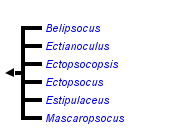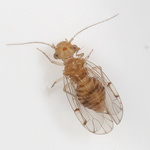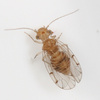Ectopsocidae
Emilie Bess and Kevin P. Johnson


This tree diagram shows the relationships between several groups of organisms.
The root of the current tree connects the organisms featured in this tree to their containing group and the rest of the Tree of Life. The basal branching point in the tree represents the ancestor of the other groups in the tree. This ancestor diversified over time into several descendent subgroups, which are represented as internal nodes and terminal taxa to the right.

You can click on the root to travel down the Tree of Life all the way to the root of all Life, and you can click on the names of descendent subgroups to travel up the Tree of Life all the way to individual species.
For more information on ToL tree formatting, please see Interpreting the Tree or Classification. To learn more about phylogenetic trees, please visit our Phylogenetic Biology pages.
close boxIntroduction
The family Ectopsocidae contains about 200 species in 6 genera distributed worldwide with highest diversity in Asia. Fourteen species are known from North America in the genera Ectopsocus and Ectopsocopsis.
These are small-sized bark lice (1.5-2.5 mm, both nymphs and adults) with robust bodies. Body colors are brown; wings are clear with or without markings. Ectopsocids inhabit dead leaves on tree branches and leaf litter.
Characteristics
Synapomorphies
- Forewing lacks areola postica.
- Hindwing veins Rs and M are connected by crossvein.
- Presence of ball-shaped lobe on meta-epimeron.
- Absence of preapical tooth of pretarsal claws.
General Characters
- Head: Antennae have 13 segments.
- Leg: Tarsi have 2 segments.
- Wings:
- Forewings are short, broad, and held in horizontal position (rather than tent-like as in other psocids).
- Forewing pterostigma is rectangular.
- Forewing areola postica is absent.
- Forewing surface is usually hairless.
- Forewing veins and margin have sarse to moderate hairs.
- Hindwing veins Rs and M are connected by crossvein in most species.
- Hindwing surface lacks hairs, may have sparse hairs on margin.
- Males:
- Epiproct frequently has combs and rugose areas.
- Phallosome has very complex, often asymmetrical, sclerotisations at tip.
- Female:
- Subgenital plate has one or two lobes.
- Gonapophyses is complete or reduced by absence of ventral valve:
- Ventral valve is pointed (when present).
- Dorsal valve is often triangular.
- External valve is elongate, parallel-sided, hairy.
- Eggs: Eggs are smooth, laid in groups, and covered with silken threads.
How to Know the Family
- Robust, small-bodied bark lice: 1.5-2.5 mm in length.
- Forewings are short, broad, and held in horizontal position (rather than tent-like as in other psocids).
- Forewing pterostigma is rectangular.
- Forewing areola postica is absent.
- Hindwing veins Rs and M are connected by crossvein.
Family Monophyly
Monophyly of Ectopsocidae is strongly supported by morphological characters, including hindwing veins Rs+M crossvein, the absence of the areola postica in the forewing, the presence of a ball-shaped lobe on the meta-epimeron, and the abscence of preapical tooth on the pretarsal claws (Yoshizawa 2002). Molecular analysis including three species of Ectopsocus showed stong support for the monophyly of the genus (18S DNA; Johnson et al. 2004), but other ectopsocid genera have not yet been included in molecular analysis.
Discussion of Phylogenetic Relationships
Both morphological and molecular data support the placement of Ectopsocidae within infraorder Homilopsocidea, although relationships within the infraorder are not well resolved (Johnson and Mockford 2003).
References
Johnson, K. P. & E. L. Mockford. 2003. Molecular Systematics of Psocomorpha (Psocoptera). Systematic Entomology 28: 409-40.
Johnson, K. P., K. Yoshizawa, and V. S. Smith. 2004. Multiple origins of parasitism in lice. Proceedings of the Royal Society of London B 271:1771-1776.
Lienhard, C. and C. N Smithers. 2002. Psocoptera (Insecta) World Catalogue and Bibliography. Muséum d'Histoire Naturelle, Geneva, Switzerland.
Mockford, E. L. 1993. North American Psocoptera (Insecta). Gainesville, Florida: Sandhill Crane Press.
New, T.R. 2005. Psocids, Psocoptera (Booklice and barklice), 2nd edition: Handbooks for the Identification of British Insects. Vol. 1, Part 7. Royal Entomological Society, London, UK.
Smithers, C. N. 1996. Psocoptera. Pp. 1-80, 363-372 (Index) in Wells A. (ed.) Zoological Catalogue of Australia. Vol. 26. Psocoptera, Phthiraptera, Thysanoptera. Melbourne: CSIRO Publishing, Australia.
Yoshizawa, K. 2002. Phylogeny and higher classification of suborder Psocomorpha (Insecta: Psocodea:'Psocoptera'). Zoological Journal of the Linnean Society 136: 371-400.
Title Illustrations

| Scientific Name | Ectopsocus |
|---|---|
| Location | Boxborough, Ma. |
| Comments | 11/26/2006 |
| Specimen Condition | Live Specimen |
| Life Cycle Stage | adult |
| View | dorsal |
| Copyright | © Tom Murray |
| Scientific Name | Ectopsocus |
|---|---|
| Location | Boxborough, Ma. |
| Comments | 11/26/2006 |
| Specimen Condition | Live Specimen |
| Life Cycle Stage | nymph |
| View | dorsal |
| Copyright | © Tom Murray |
About This Page
Emilie Bess

Illinois Natural History Survey, Champaign, Illinois, USA
Kevin P. Johnson

Illinois Natural History Survey, Champaign, Illinois, USA
Correspondence regarding this page should be directed to Emilie Bess at and Kevin P. Johnson at
Page copyright © 2009 Emilie Bess and Kevin P. Johnson
All Rights Reserved.
- First online 25 March 2009
- Content changed 25 March 2009
Citing this page:
Bess, Emilie and Kevin P. Johnson. 2009. Ectopsocidae. Version 25 March 2009 (under construction). http://tolweb.org/Ectopsocidae/14472/2009.03.25 in The Tree of Life Web Project, http://tolweb.org/









 Go to quick links
Go to quick search
Go to navigation for this section of the ToL site
Go to detailed links for the ToL site
Go to quick links
Go to quick search
Go to navigation for this section of the ToL site
Go to detailed links for the ToL site